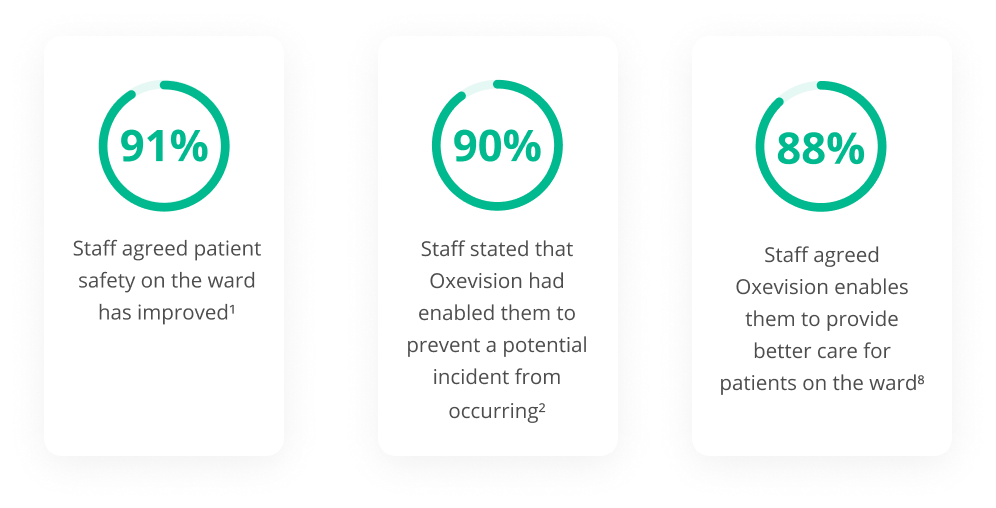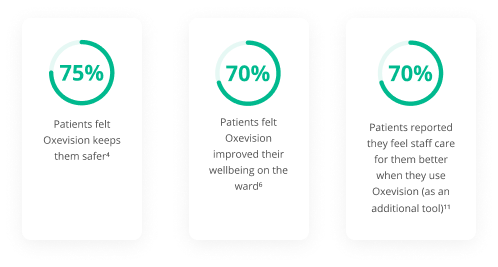Enhancing patient safety with innovative technology
February 2021
Oxehealth’s Oxevision platform for inpatient wards allows clinicians in mental health trusts to plan patient care and to intervene proactively.
Oxehealth began installing Oxevision technology at Essex Partnership University NHS Foundation Trust (EPUT) last year as part of a 12-month pilot project. Since then EPUT has expanded its use of the platform to a number of other adult and child inpatient mental health wards. In this impact story we present EPUT’s first insights into how the platform has improved patient safety and quality, as well as highlighting key learning.
UCLPartners are working with Oxehealth on a larger scale real world validation at EPUT and supporting the technology’s adoption at other NHS Trusts.
The Challenge
Working on a mental health ward can be extremely challenging but also rewarding. To ensure the safety of mental health patients, staff need to regularly monitor their physical and mental health and their safety. However, this can be intrusive and potentially diminish trust and inhibit relationships with patients
To engage in therapy and recovery, patients often need to feel safe and heard and a traditional monitoring approach can diminish the likelihood of both of these.
There has historically been an absence of effective technologies that can support clinical teams by giving them early warning signs and risk factors through non-contact physiological and physical monitoring.
The Solution
Oxevision gives teams the clinical insights they require to plan patient care and proactively intervene to help their patients, delivering safer, higher quality and more efficient care.
The platform uses a contact-free optical sensor (camera + infrared illumination) to unobtrusively monitor patients in bedrooms 24/7. No equipment touches the patient, and staff receive data via a fixed monitor and portable tablet devices.
Clinicians can take medical grade cardio-respiratory measurements remotely and access vital sign trends over time, all without entering the bedroom, which is particularly valuable at night when patients need to rest. Staff receive real-time alerts to high-risk activity, prompting a safety check and can view activity and behavioural trend data. As a tool it empowers staff to use clinical skill and judgement, helping inform the decision of when to intervene through the provision of actionable objective data and clinical insights. It can help reduce potential incidents and quicken observation rounds, allowing staff to redeploy time to care.
Oxevision is real-world validated and has supported over 4 million hours of care.
This specific implementation was recently presented at the UCLPartners events on challenges and solutions in NHS mental health trusts and Oxehealth has recently been selected to be part of the DigitalHealth.London Accelerator 2020-2021.

Current and Continuing Impact
Essex Partnership University NHS Trust have partnered with Oxehealth to improve the safety, quality and efficiency of care on their inpatient mental health wards. Together they are conducting a real-world evaluation to measure the impact over time, due to continue throughout 2021 and early 2022.
After three months, early insights were gathered from the first two wards to go live through surveys, interviews and focus groups of service users, ward staff and management.
Our partnership with Oxehealth is supporting our teams to enhance the care on our wards. Our ambition is to be a safety-first organisation – staff now have another tool to provide safer, high-quality care. Patients have said they feel safer and their wellbeing has improved.
Janette Leonard, Director of IT, Business Analysis and Reporting.
Staff have found Oxevision to have a positive impact on patient care. By having this additional tool, staff are able to use their clinical skill to decide when to intervene, and can safely monitor patients overnight without disturbing them.
With the extra support provided, staff find they can approach decisions with more confidence, and modify clinical interventions to break the cycle of challenging behaviour so patients can engage with their recovery.
Now you can take time to have that meaningful interaction and say ‘How are you?’, not just being reactive to an incident. We purposefully go to have a 1-1 conversation.
Ann Teemal, Ward Manager.
Although the evaluation is still in its early stages, there are signs that Oxevision is delivering operational benefits. These include reducing the number of avoidable 1-1 observations, stepping down restrictive observations and allowing staff to complete observation rounds more quickly so they can spend more time on other areas of care.
Right now, we have 7 of our 15 patients on enhanced observations and I’d say we could confidently step down 5 of those with the help of Oxehealth.
Chloe Cawston, Service Manager.

Shared learning about implementation
Installation on some of the wards took place during the COVID-19 pandemic which meant conditions were challenging but it was nevertheless very successful. The partners identified a number of points of learning on how to run a successful and timely intervention:
- Frequent, consistent patient engagement was key to mitigating any stress from changes in activity on the ward. This took the form of regular meetings, 1-2-1s, leaflets and posters to keep patients informed of the process and how it would impact them.
- Critical to success is a close working relationship with the clinical team to understand existing operational policies and protocols and agree on how the technology can be truly functional in the setting. This enabled a change of policies to integrate Oxevision into existing ways of working and ensure it was easy to adopt and maintain.
- Partnership working with open communication and quick responses was essential to providing an overall smooth launch
- A sense of staff ownership is crucial to effective usage and this was established through regular touch points and training sessions.
I think Oxehealth makes us very safe on the ward. I find it hard to ask for help when I need it, or even admit to the staff that I might need help. Having Oxehealth, you know that it alerts staff when you need them and that they will come and help you. It’s good to know that it calls for help when you need it, but also, when you don’t think you need help.
Rita, patient, acute female ward.
We wanted to involve the patients throughout because, ultimately it’s for them. They liked that we were open and honest with them, which improved the staff and patient relationship.
Chloe Cawston, Service Manager.
A full copy of the evaluation report can be downloaded from the Oxehealth website.
Footnotes: 1 N=33; 2 N=31; 8 N=33; 4 N=12; 6 N=10; 11 N=32